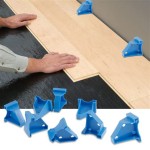Vinyl flooring transition strips are important components of any flooring installation. They are designed to bridge two different types of flooring, which can be joined together at different levels. Transition strips can be used to transition between two different types of vinyl flooring, carpet, tile, or hardwood. They are also used to create a smooth transition between two different heights or thicknesses of flooring. In this article, we’ll discuss the different types of vinyl flooring transition strips and how to install them.
Types of Vinyl Flooring Transition Strips
The type of transition strip you’ll need will depend on several factors, including the type of flooring being installed, the height or thickness of the flooring, and the shape of the room. The most common types of transition strips are T-moldings, reducers, end caps, stair nosings, and overlap reducers.
- T-Moldings: These are the most common type of transition strips and are used when the two floors being connected have the same thickness and height. They are shaped like a “T” and are used to bridge the gap between floors of the same height.
- Reducers: Reducers are used when the two floors being connected have different heights. They are designed to transition between two different heights and create a smooth transition between the two floors.
- End Caps: End caps are used to transition between two different thicknesses of flooring. They are designed to provide a smooth transition between two different thicknesses.
- Stair Nosings: Stair nosings are transition strips designed to transition between two different floor heights, such as between a step and a flat surface. They are designed to provide a smooth transition between two different floor heights.
- Overlap Reducers: Overlap reducers are used to transition between two different floor heights, such as between a step and a flat surface. They are designed to provide a smooth transition between two different floor heights and are often used in staircases.
Installing Vinyl Flooring Transition Strips
Installing vinyl flooring transition strips is relatively simple and can be done by most do-it-yourselfers. First, measure the area where the transition strip will be installed and cut the transition strip to size. Make sure that the transition strip is cut to the same width as the flooring. Next, apply a bead of construction adhesive to the back of the transition strip and press it firmly into place. Finally, use a hammer and nails to secure the transition strip in place.
Benefits of Vinyl Flooring Transition Strips
Vinyl flooring transition strips are an important part of any flooring installation. They are designed to bridge two different types of flooring, which can be joined together at different levels. Transition strips can be used to transition between two different types of vinyl flooring, carpet, tile, or hardwood. They are also used to create a smooth transition between two different heights or thicknesses of flooring. In addition, transition strips are easy to install and provide a professional, polished look to any flooring installation.
Conclusion
Vinyl flooring transition strips are an important component of any flooring installation. They are designed to bridge two different types of flooring, which can be joined together at different levels. Transition strips can be used to transition between two different types of vinyl flooring, carpet, tile, or hardwood. They are also used to create a smooth transition between two different heights or thicknesses of flooring. Transition strips are easy to install and provide a professional, polished look to any flooring installation.















Related Posts








